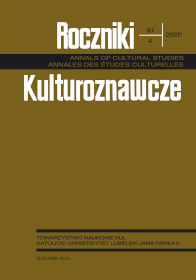What Does the Middle Ages Teach Us for Today?
Abstract
Insofar as it is possible to use history to understand one’s time, three main lessons can be drawn from the study of the Middle Ages. First, repeated confrontation with new populations did not prevent the foundation of a single cultural community. Then, among the causes that allowed this assimilation, there is what could be called an “inferiority complex,” which paradoxically pushed the men of the Middle Ages to constantly innovate out of admiration for their prestigious predecessors. Finally, the desire for unity was allied with numerous tensions and a de facto pluralism, since the poles around which to unify were themselves several: philosophical wisdom inherited from Athens, civil law transmitted from Rome, the Christian faith received from Jerusalem.
References
Ampère, Jean-Jacques. Histoire littéraire de la France avant le xiiie siècle. Paris: Hachette, 1838.
Augustine. De Civitate Dei, edited by Bernard Dombart and Alphonsus Kalb. Corpus Christianorum, Series Latina, 47–48. Turnhout: Brepols, 1955.
Bermond, Pascale, and Isabelle Moulin (eds.). Commenter au Moyen Âge. Paris: Vrin, 2020.
Blanchard, Joël. La fin du Moyen Âge. Paris: Perrin, 2020.
Dahan, Gilbert. Les intellectuels chrétiens et les juifs au Moyen Âge. Patrimonies, judaïsme. Paris: Cerf, 1990.
Dahan, Gilbert. L’exégèse chrétienne de la Bible en Occident médiéval, XIIe-XIVe siècle. Patrimoines, Christianisme. Paris: Cerf, 1999.
Emery, Gilles, and Matthew Levering (eds). The Oxford Handbook of the Trinity. Oxford: Oxford University Press, 2011.
Fontaine, Jacques, and Christine Pellistrandi. L’Europe héritière de l’Europe wisigothique. Madrid: Casa de Velazquez, 1992.
Ghellinck, Joseph. “Nani et gigantes.” Archivum Latinitatis Medii Aevi 18 (1943–1944): 25–29.
Goffart, Walter A. Barbarians and Romans AD 418-584. The Techniques of Accommodation, Princeton: Princeton University Press, 1980.
Heather, Peter J. The Fall of the Roman Empire. A New History. London: Macmillan, 2005.
Hamesse, Jacqueline, and Olga Weijers. Écriture et réécriture des textes philosophiques médiévaux. Volume d’hommage offert à Colette Sirat. Textes et études du Moyen Age. Turnhout: Brepols, 2006
Harris, Jonathan. The End of Byzantium. Yale: Yale University Press, 2010.
Haskins, Charles Homer. The Renaissance of the Twelfth Century. Cambridge: Cambridge University Press, 1927.
Hugh of Saint-Victor. Didascalicon, edited by Charles Henry Buttimer: Hugonis de Sancto Victore. Didascalicon. De Studio Legendi. Washington: Catholic University Press, 1939; English translation of Jerome Taylor: The Didascalicon of Hugh of St Victor. New York: Columbia University Press, 1961; and the recent translation of Franklin T. Harkins in: Franklin T. Harkins and Frans van Liere (eds). Interpretation of scripture: theory. A selection of works of Hugh, Andrew, Richard and Godfrey of St Victor, and of Robert of Melun. Turnhout: Brepols, 2012.
Huyzinga, Johan. Herfsttij der Middeleeuwen. Leiden: Leiden University Press, 2018 (1st ed. 1919). Translated as The Waning of the Middle Ages. London: Penguin Books, 1924.
Jeauneau, Éduard de. “Lectio philosophorum”. Recherches sur l’École de Chartres, 51–74. Amsterdam: Adolf M. Hakkert, 1973.
Jeauneau, Éduard de. “Nani gigantum humeris insidentes. Essai d’interprétation de Bernard de Chartres.” Vivarium 5 (1967): 79-99. DOI: https://doi.org/10.1163/156853467X00078.
John of Salisbury. Metalogicon, edidit John Bernie Hall, auxiliante K.S.B. Keats-Rohan: Iohannis Saresberiensis Metalogicon. Corpus Christianorum Continuatio Mediaevalis, 98. Turnhout: Brepols, 1991.
Nathan, Geoffrey. “The Last Emperor: The Fate of Romulus Augustulus.” Classica et Mediaevalia 43 (1992): 261–271.
Naumann, Hans. Karolingische und ottonische Renaissance. Frankfurt am Main: Englert und Schlosse, 1927.
Neuman de Vegvar, Carl L. The Northumbrian Renaissance: a study in the transmission of style. Cranbury: Associated University Press, 1987.
Patzelt, Ema. Die Karolingische Renaissance. Beiträge zur Geschichte der Kultur des frühen Mittalters. Wien: Österreichischer Schulbücherverlag, 1924.
Pierre de Blois. Epistula 92. PL 207, 290AB.
Rashdall, Hastings, Frederick Maurice Powicke, and Alfred Brotherstan Emden. The Universities of Europe in the Middle Ages, 3 vol. Oxford: Clarendon Press, 1987.
Riché, Pierre. Éducation et culture dans l’Occident barbare, VIe-VIIIe siècle. Patristica Sorbonensia, 4. Paris: Seuil, 1962.
Verger, Jacques. La Renaissance du XIIe siècle. Initiations au Moyen Âge. Paris: Cerf, 1999.
Weijers, Olga. In Search of the Truth: A History of Disputation Techniques from Antiquity to Early Modern Times. Studies on the Faculty of Arts, History and Influence, 1. Turnhout: Brepols, 2013.
Wright, Thomas (ed.). Alexandri Neckham De naturis rerum libri duo. Rolls Series, 34. London: Longman and Green, 1863.
Zimmermann, Michel (ed.), Auctor et auctoritas. Invention et conformisme dans l’écriture médiévale. Actes du colloque tenu à l’Université deVersailles — Saint-Quentin-en-Yvelines (14–16 juin 1999). Mémoires et documents de l’École des chartes, 59. Paris: École nationale des chartes, 2001.





